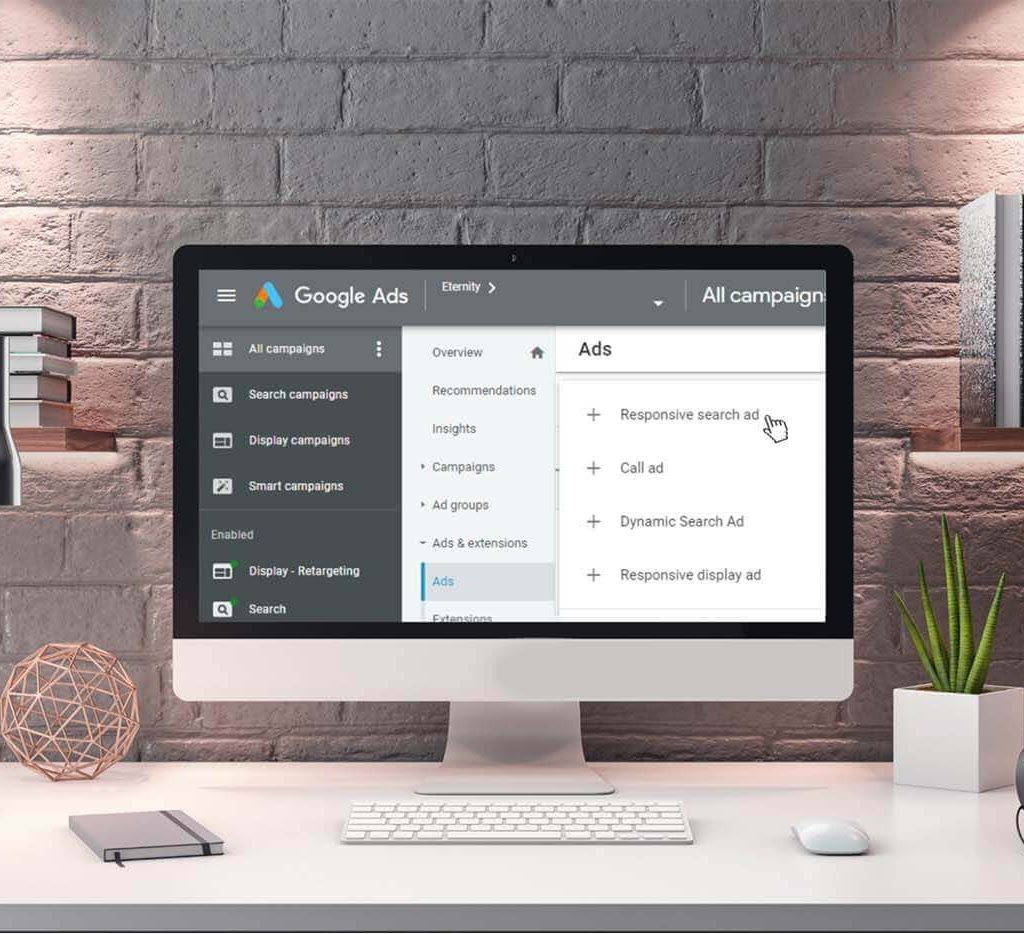Did you know you can automate your Google Ads campaigns and ensure they are continuously optimized? It’s known as Responsive Search Ads, and it has the potential to take your digital campaigns to the next level.

Responsive Search Ads are Google Ads’ newest offering, allowing you to easily create ads that adjust to different types of search queries to maximize exposure and engagement. With responsive search advertisements, you can make an advertisement that changes based on the keywords a user enters in their search query, guaranteeing that more people likely to be interested in your offer will see it.
In this article, we’ll cover everything you need to know about Responsive Search Ads and how they work in Google Ads. By the end, you’ll know why Responsive Search Ads are a powerful tool for boosting ROI. Ready? Let’s get started!
What Are Responsive Search Ads?
Responsive Search Ads (RSAs) are a powerful Google Ads feature that allows you to create highly optimized advertisements for your target audience. With RSAs, you don’t need to manually test and optimize personal ads—Google Ads will do the work for you.

With RSAs, you enter up to 15 headlines and four descriptions, giving your potential customers numerous combinations of headlines and descriptions that Google Ads can use in your ads. This means the result is an ad tailored to the user’s search query.
From there, Google Ads will test different combinations of the given headlines and descriptions for each user to find the best-performing ad possible—all of this happens automatically in just a few clicks. This optimization method ensures maximum value from each dollar spent when advertising on Google Ads.
How Does Google Ads Generate Responsive Search Ads?
Google Ads Responsive Search Ads (RSAs) can generate up to 15 versions of your ad. This is made possible by machine learning that helps the platform understand which combinations of headlines and descriptions are most effective at resonating with your target audience. The more you provide, the better the ad can be tailored to your needs.

Moreover, Google Ads will automatically optimize your ad copy’s placement and variations by testing various combinations on different platforms and with different audiences to identify which ones increase user engagement. This means that RSAs effectively use every keyword, so you get all the potential leads.
This automated-generated ad optimization accommodates a wide range of user preferences and speeds up your time-to-result while creating eye-catching ads that draw in more customers. With Responsive Search Ads, you can let Google Ads do the heavy lifting while you reap the rewards.
Benefits of Responsive Search Ads
- Make advertising adaptable to the size of your device, giving you more space to communicate with potential clients.
- Save time by providing multiple headline and description options, allowing Google Ads to show the most relevant combinations to your customers.
Automated Ad Variations
When you create Responsive Search Ads, Google Ads automatically generates multiple ad variations based on the ad text, headlines, and descriptions you provide. This means that rather than manually writing hundreds of variations of an ad, you only need to give a few different components, and Google takes care of the rest. This allows you to quickly create ads tailored to your target audience while being dynamic enough to adapt to changing market conditions.
Targeted Audiences
You can target particular audiences with responsive search ads tailored to their needs and interests. Advanced targeting options simplify customizing your message and attract more relevant traffic to your website, such as automatic audience creation, in-market segments, custom intent audiences, and lookalike audiences.
Optimized Performance
Google’s AI algorithms constantly learn from each impression and click on your ads, receiving and testing different text, headline, and description combinations to optimize performance over time. This ensures that the ads served are the most relevant based on user intent, resulting in higher engagement rates, better conversion rates, and overall improved ROI for your campaigns.
Creating and Optimising Responsive Search Ads With Google Ads
So, how does Google Adwords produce responsive search ads?

Businesses may broaden their reach and build more effective ad campaigns using responsive search ads with Google AdWords. Connecting with potential customers on desktop and mobile devices is a fantastic method, and this is how it goes:
Writing Ad Copy
Writing the ad copy is the first step to creating your Responsive Search Ad. You’ll need to develop 15 headline options and four description options, which you can later test, track, and optimize to get the best results. The more creative you can be with your copywriting, the better!
Setting Up Your Campaigns
Once your ad copy is ready, you can set up your campaigns. Google Ads recommends including two to three Responsive Search Ads per ad group in a campaign – this allows for enough variation to test and optimize your ads over time. To get the most out of your Responsive Search Ad campaigns, use Smart Bidding for more innovative bidding strategies based on data such as device type or audience demographics.
Optimizing Your Campaigns
Google Ads will show different combinations of your headlines and descriptions depending on what it thinks is most likely to perform well for each keyword you’re targeting. You can monitor these combinations over time to see which ones are working best so that you can optimize your ads accordingly. This helps ensure you’re reaching the right people with the right message – maximizing the effectiveness of your campaigns!
Tips for Writing Effective Responsive Search Ad Copy
Remembering a few things when writing compelling, responsive search ads would be best. Here are some tips for getting the most out of your Google Ads campaigns and writing persuasive copy for your responsive search ads.

Know Your Audience
Knowing your audience is essential for crafting persuasive copy. Focus on finding the correct audience when creating your ad copy—those who will be most interested in what you have to offer. Consider your target market’s demographic, psychographic, and geographic characteristics as you write advertising that speaks to them specifically.
Feature Your Unique Selling Proposition (USP)
In persuasive writing, you want to ensure that your ad copy highlights why customers should choose you over a competitor. Feature the USP of your products or services to create an emotional connection with potential customers and highlight why they should choose you over others.
Use Actionable Language
Make sure that you use actionable language in your ad copy to drive people to click on your link—words like “Try,” “Shop,” or “Buy” can be powerful calls to action when used sparingly and strategically.
Focus On Benefits, Not Features
You must focus on highlighting the benefits of what you offer instead of just listing features—this will help capture the attention of potential customers quickly by focusing on how they can benefit from working with you.
By following these tips, you can ensure your responsive search ad copy is engaging and persuasive, helping drive more organic clicks from potential buyers!
Measuring the Success of Your Responsive Search Ad Campaigns
Measuring your campaigns’ success is essential when using Google Ads to generate responsive search ads. This means tracking metrics such as impressions, clicks, engagement rates, cost-per-click (CPC), conversions, and click-through rate (CTR).
These metrics will give insight into your responsive search ad campaigns’ performance and success.

Impressions vs Clicks
Impressions measure the number of times an ad is served up to a user, while clicks measure the number of times a user clicks on the ad. This data shows how effectively your ad grabs people’s attention.
Engagement Rates & CPCs
Engagement rates measure the ratio between impressions and clicks; your ad will likely grab people’s attention if this rate is high. Similarly, cost-per-click (CPC) estimates what it costs you each time someone clicks on your ad—if this number is high, it could mean your ad isn’t being clicked as much as it should be.
Conversions & CTRs
Conversions measure how often users perform specific actions after clicking on an ad—for example, buying a product or signing up for a service. Click-through rate (CTR) measures the ratio between impressions and clicks; if this rate is low, fewer people engage with your ads even after they’ve served them.
By monitoring these metrics continuously, you can evaluate and adjust your responsive search ads accordingly to ensure you’re getting maximum results from each campaign.
Conclusion
Are you prepared to explore all of the potentials of Google Ads? You may maximize the effectiveness of your Google Ads campaigns by using responsive search ads. You may immediately benefit your business with the appropriate fusion of creativity and statistics. You’ll be able to attract more relevant visitors to your website and learn essential things about how people behave. Additionally, you’ll be able to tune your campaigns for the best ROI and cost efficiency. You can ensure you’re using your resources wisely and getting the most out of your Google Ads campaigns with responsive search ads.



Add a Comment